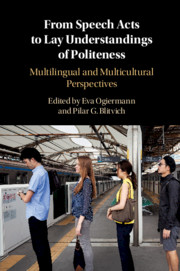Book contents
- From Speech Acts to Lay Understandings of Politeness
- From Speech Acts to Lay Understandings of Politeness
- Copyright page
- Contents
- Figures
- Tables
- Contributors
- Im/politeness between the Analyst and Participant Perspectives: An Overview of the Field
- Part I Concepts and Cultural Norms Underlying Speech Acts
- Part II Concepts and Cultural Norms Underlying Politeness
- 7 Notions of Politeness in Britain and North America
- 8 The Metapragmatics of Consideration in (Australian and New Zealand) English
- 9 A Metapragmatic Aspect of Politeness: With a Special Emphasis on Attentiveness in Japanese
- 10 Discussions on Swiss and German Politeness in Online Sources
- 11 Globalisation and Politeness: A Chinese Perspective
- 12 Emic Conceptualizations of Face (Imagen) in Peninsular Spanish
- Epilogue: Personal Encounters with Politeness Research
- Index
- References
12 - Emic Conceptualizations of Face (Imagen) in Peninsular Spanish
from Part II - Concepts and Cultural Norms Underlying Politeness
Published online by Cambridge University Press: 14 June 2019
- From Speech Acts to Lay Understandings of Politeness
- From Speech Acts to Lay Understandings of Politeness
- Copyright page
- Contents
- Figures
- Tables
- Contributors
- Im/politeness between the Analyst and Participant Perspectives: An Overview of the Field
- Part I Concepts and Cultural Norms Underlying Speech Acts
- Part II Concepts and Cultural Norms Underlying Politeness
- 7 Notions of Politeness in Britain and North America
- 8 The Metapragmatics of Consideration in (Australian and New Zealand) English
- 9 A Metapragmatic Aspect of Politeness: With a Special Emphasis on Attentiveness in Japanese
- 10 Discussions on Swiss and German Politeness in Online Sources
- 11 Globalisation and Politeness: A Chinese Perspective
- 12 Emic Conceptualizations of Face (Imagen) in Peninsular Spanish
- Epilogue: Personal Encounters with Politeness Research
- Index
- References
Summary
Garcés-Conejos Blitvich and Bou-Franch’s chapter aims to throw light on emic understandings of face1 and imagen1 in Peninsular Spanish, and to compare such understandings with etic approaches to imagen and identity. A three-pronged methodology is used to tease out lay meanings of imagen from different first-order sources, and includes the examination of monolingual and bilingual dictionaries, the analysis of a corpus of Spanish newspapers, and the analysis of data from focus groups discussing situated experiences of imagen1. The results show that imagen1 and face1 are not related in a straightforward manner. Whereas imagen2 draws on Goffman’s and Brown and Levinson’s seminal definitions of the construct, imagen1 does not always evoke imagen2; when it does, it is more closely related to Goffman’s than to Brown and Levinson’s conception.Microanalysis of naturally-occurring discourse focusing on experiences of imagen1 shows how uses of imagen1 pointed to the centrality of identity and its relationship with face1. The author’s findings thus give credence to that fact that face and identity co-constitute each other and are hard to separate theoretically and analytically.
Keywords
- Type
- Chapter
- Information
- From Speech Acts to Lay Understandings of PolitenessMultilingual and Multicultural Perspectives, pp. 301 - 327Publisher: Cambridge University PressPrint publication year: 2019
References
- 4
- Cited by



